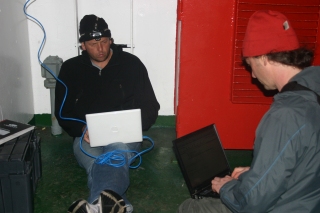I-TASC Antarctica expedition 2006-07 – aboard SA Agulhas icebreaker
Just 4 days to go, and it looks like we may spend our first full day on the continent of Antarctica on Christmas Day. As a child growing up in New Zealand, it struck me as odd that the Christmas songs always spoke about snow and sleighs and enjoying a white Christmas. New Zealand has Christmas in Summer, and the only thing white at that time of year is sand and pavlova. I wondered if I would ever see a white Christmas, and imagined what it would be like. I never quite thought it would be like this.
We are now parked at Penguin Bukta with the nose of the boat resting on the ice shelf. Looking along the giant wall, you see the rounded droopy overhangs giving the appearance of one long frozen tidal wave like the tsunami painted by Japanese painter Hokusai.

The bulldozing team are in their dozers on top of the shelf, digging a path so the ship can offload the gear. The shelf is too high for the boat’s crane to reach, so they have to cut a slope down through the ice to a level the crane can reach. It’s not safe work as there are dangerous overhangs in the cliffs . As recently as last year, they almost lost a few dozers when the shelf collapsed. We sit in the boat and wait and watch occasionally what is happening on the ice some 20 meters above us.
If you look down at the bow, you can see the shifting tones of turquoise and aqua of the shelf as it runs deeply below us. The gently rippling water shifts the light and color below us and it has something of the appearance of an aurora in the sea.

Some of the over-winter team have come aboard. It’s been weird these last days, we have noticed some new faces and kidded ourselves that SANAE must have some scary genetics lab deep in the hull of the boat where they manufacture new crew for the base. If so, then their experiments went a bit mad as the over-winter team look pretty wild. Long beards, hair all over the place, and did I imagine a slightly mad look in their eyes? I think possibly so… still, they are a weird sight to come across in the hallways after not having seen a new face for 2 weeks or so.
I have also met a chap on the boat that is a Linux geek. I am trying not to embarrass myself by talking Unix as a default conversation with him as I do enjoy software politics, and don’t want to scare anyone with my fanaticism. I think I see the same dark fear in his soul as he is a Slackware user, which is about as hardcore as you can get. I am sure that sometime while we are at the base we will degenerate our discussions into obscure file formats and OS wars to the exclusion of all. Als,o there is a guy Tom talked to that is interested in running the FM station I am to build as a
r a d i o q u a l i a project while at the base. He will be over-wintering and will run it through winter. The trick is to test the transmitter to see if it will get the 100 or so miles to Neumayer, as he is keen to broadcast to them. I don’t think it will do it, so we may have to fly in another transmitter.
After a slightly spicy meeting yesterday things seem to have settled down. Routine and knowing what the plan is (ie. the boat isn’t going anywhere for 3 days) helps reduce anxiety. It’s good things feel calmer as it’s a great team and temporary bumps, however predictable, are still frustrating. I am working on my slide shows; I think its a nice format… they aren’t finished but as soon as I get some bandwidth, I will upload them, probably after Christmas.
 Today we slept late and worked only a little together as the I-TASC crew. It was a day off as it is Sunday. I passed the ship’s bar and TV lounge before lunch to see a small group of 7 or 8 people using the space as a makeshift church. During the afternoon, I read more about Shackleton’s amazing journey in his own words. Unbelievable. They seemed to survive for almost 18 months with little more than we would throw away in a week. I learned some Dutch a bit later then met the crew for dinner. After dinner, we met with Pierre and tried getting connected to the net via a BGAN terminal. We squatted on a high deck and tried to find the satellite in the dark, windy and cold night. We soon had a good connection and we were able to put up the Interpolar and I-TASC websites easily.
Today we slept late and worked only a little together as the I-TASC crew. It was a day off as it is Sunday. I passed the ship’s bar and TV lounge before lunch to see a small group of 7 or 8 people using the space as a makeshift church. During the afternoon, I read more about Shackleton’s amazing journey in his own words. Unbelievable. They seemed to survive for almost 18 months with little more than we would throw away in a week. I learned some Dutch a bit later then met the crew for dinner. After dinner, we met with Pierre and tried getting connected to the net via a BGAN terminal. We squatted on a high deck and tried to find the satellite in the dark, windy and cold night. We soon had a good connection and we were able to put up the Interpolar and I-TASC websites easily.